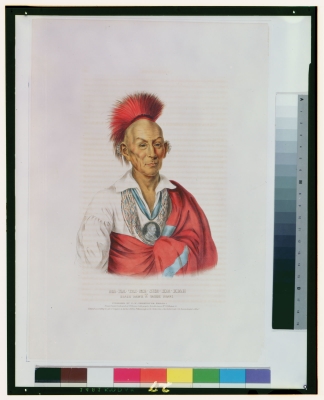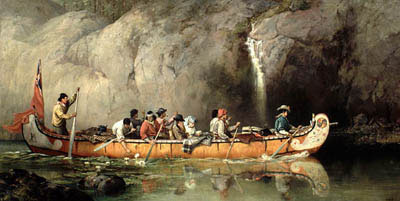Browse "Indigenous People"
-
Article
107th Timber Wolf Battalion
The 107th (Timber Wolf) Battalion, Canadian Expeditionary Force, known officially as the 107th (Winnipeg) Battalion, was an infantry battalion established during the First World War. After it arrived in Britain, the unit was converted to a pioneer battalion and served on the Western Front in France and Belgium. It was later absorbed into an engineer brigade. About half the unit’s soldiers were Indigenous Canadians.
"https://d2ttikhf7xbzbs.cloudfront.net/media/new_article_images/107thTimberWolfBattalion/107th_cap_badge.jpg" // resources/views/front/categories/view.blade.php
https://d2ttikhf7xbzbs.cloudfront.net/media/new_article_images/107thTimberWolfBattalion/107th_cap_badge.jpg
-
Article
A Dish with One Spoon
The term a dish with one spoon refers to a concept developed by the Indigenous peoples of the Great Lakes region and northeastern North America. It was used to describe how land can be shared to the mutual benefit of all its inhabitants. According to the Haudenosaunee (Iroquois), the concept originated many hundreds of years ago and contributed greatly to the creation of the “Great League of Peace” — the Iroquois Confederacy made up of the Seneca, Cayuga, Oneida, Onondaga, and Mohawk nations. The Anishinaabeg (the Ojibwe, Odawa, Potawatomi, Mississauga, Saulteaux and Algonquin nations) refer to “a dish with one spoon” or “our dish” as “Gdoo – naaganinaa.”
"https://d2ttikhf7xbzbs.cloudfront.net/media/media/122dc04b-d0a1-4551-a912-1bee8991746b.jpg" // resources/views/front/categories/view.blade.php
https://d2ttikhf7xbzbs.cloudfront.net/media/media/122dc04b-d0a1-4551-a912-1bee8991746b.jpg
-
Article
Indigenous Title and the War of 1812
In the first decade of the 19th century, relations between Great Britain and the United States deteriorated, primarily due to the widening influence of the Napoleonic Wars. At the centre of this movement, two Shawnee brothers implored Indigenous peoples to unite in order to defend their dwindling lands against the growing incursions of Anglo-American settlers and the United States government. The promise of an Indigenous state never came to fruition. After the War of 1812, the United States and Britain found it more advantageous to ignore Aboriginal title.
"https://d2ttikhf7xbzbs.cloudfront.net/media/media/643cf6b2-b555-4624-bac0-8717cf614cf6.jpg" // resources/views/front/categories/view.blade.php
https://d2ttikhf7xbzbs.cloudfront.net/media/media/643cf6b2-b555-4624-bac0-8717cf614cf6.jpg
-
Article
Abraham Ulrikab
Abraham Ulrikab (born 29 January 1845 in Hebron, Labrador; died 13 January 1881 in Paris, France) was one of eight Labrador Inuit to die from smallpox while travelling through Europe as part of an ethnographic show (now called human zoos). In 2011, his skeleton, along with that of four other Inuit, was uncovered in the reserves of the Muséum national d’histoire naturelle (National Museum of Natural History) in Paris. The Nunatsiavut government (See Labrador Inuit) is studying the possibility of having them repatriated.
"https://d2ttikhf7xbzbs.cloudfront.net/media/new_article_images/AbrahamUlrikab/Photograph-of-Abraham-Ulrikab.jpg" // resources/views/front/categories/view.blade.php
https://d2ttikhf7xbzbs.cloudfront.net/media/new_article_images/AbrahamUlrikab/Photograph-of-Abraham-Ulrikab.jpg
-
Article
Alexander Monkman
Alexander Monkman, trader, rancher, promoter (b at Manitoba House, Man 29 March 1870; d at Grande Prairie, Alta 26 September 1941).
"https://d2ttikhf7xbzbs.cloudfront.net/media/media/f703ac5f-d24d-41d1-a329-b0aa21b1672d.jpg" // resources/views/front/categories/view.blade.php
https://d2ttikhf7xbzbs.cloudfront.net/media/media/f703ac5f-d24d-41d1-a329-b0aa21b1672d.jpg
-
Article
Alikomiak and Tatimagana
Alikomiak (also spelled Alekámiaq) and Tatimagana, Inuit hunters from the central Arctic, were the first Inuit to be condemned and executed for murder under Canadian law on 1 February 1924. The trials of Alikomiak and Tatimagana have been described as demonstrations of federal authority over the Inuit as well as of Canadian sovereignty in the Arctic.
"https://d2ttikhf7xbzbs.cloudfront.net/media/media/555fb88f-02be-435e-9f45-a8bdcb6dbe1c.jpg" // resources/views/front/categories/view.blade.php
https://d2ttikhf7xbzbs.cloudfront.net/media/media/555fb88f-02be-435e-9f45-a8bdcb6dbe1c.jpg
-
Article
Almighty Voice
Almighty Voice (or Kitchi-manito-waya, meaning “Voice of the Great Spirit,” also known as Jean-Baptiste), Cree, outlaw (born around 1875 near Duck Lake, SK; died 30 May 1897 at Batoche, SK).
"https://d2ttikhf7xbzbs.cloudfront.net/AlmightyVoice.jpg" // resources/views/front/categories/view.blade.php
https://d2ttikhf7xbzbs.cloudfront.net/AlmightyVoice.jpg
-
Article
Anahareo
Anahareo, or Gertrude Philomen Bernard, CM, conservationist, prospector (born 18 June 1906 in Mattawa, ON; died 17 June 1986 in Kamloops, BC). An independent, forceful animal welfare advocate, Anahareo is credited with converting her well-known husband, Grey Owl, into a conservationist.
"https://d2ttikhf7xbzbs.cloudfront.net/media/new_article_images/Anahareo/pd-393-3-59.jpg" // resources/views/front/categories/view.blade.php
https://d2ttikhf7xbzbs.cloudfront.net/media/new_article_images/Anahareo/pd-393-3-59.jpg
-
Article
Peter Bostonais Pangman
Peter (or Pierre) Bostonais Pangman, Métis leader, bison hunter (born 20 October 1791 in the North Saskatchewan River Valley area, present-day AB; died 4 March 1850 in St. François Xavier, present-day MB). Peter Bostonais Pangman was a skilled hunter who helped provide much-needed bison meat to the Red River Colony. He was actively involved in the Pemmican Wars and events surrounding the Battle of Seven Oaks. As part of the Pembina fur trade, Pangman was a key figure who rallied and inspired the Red River Valley Métis to see and express themselves with an identity separate from surrounding Indigenous peoples. The name Bostonais is variously spelled Bastonnais and Bostonnais.
"https://development.thecanadianencyclopedia.ca/images/tce_placeholder.jpg?v=e9dca980c9bdb3aa11e832e7ea94f5d9" // resources/views/front/categories/view.blade.php
https://development.thecanadianencyclopedia.ca/images/tce_placeholder.jpg?v=e9dca980c9bdb3aa11e832e7ea94f5d9
-
Article
Beothuk
Beothuk (meaning “the people” or “true people” in their language) were an Indigenous people who traditionally inhabited Newfoundland. At the time of European contact in the 16th century, the Beothuk may have numbered no more than 500 to 1,000. Their population is difficult to estimate owing to a reduction in their territories in the early contact period. While it has been said that the Beothuk are now extinct, Mi’kmaq oral tradition denies this claim. Indigenous oral histories teach that the Beothuk intermarried with other Indigenous nations along the mainland after they had been forced out of their coastal territories by settlers. According to this perspective, Beothuk descendants live on in other Indigenous communities.
"https://d2ttikhf7xbzbs.cloudfront.net/media/media/5a96371d-c37d-49fd-a6da-ab62b28474d0.jpg" // resources/views/front/categories/view.blade.php
https://d2ttikhf7xbzbs.cloudfront.net/media/media/5a96371d-c37d-49fd-a6da-ab62b28474d0.jpg
-
Article
Mistahimaskwa (Big Bear)
Mistahimaskwa (Big Bear), Plains Cree chief (born near Fort Carlton, SK; died 17 January 1888 on the Little Pine Reserve, SK). Mistahimaskwa is best known for his refusal to sign Treaty 6 in 1876 and for his band’s involvement in violent conflicts associated with the 1885 North-West Resistance.
"https://d2ttikhf7xbzbs.cloudfront.net/media/media/d3f8c588-0cfa-414d-b360-98aa3449b9e1.jpg" // resources/views/front/categories/view.blade.php
https://d2ttikhf7xbzbs.cloudfront.net/media/media/d3f8c588-0cfa-414d-b360-98aa3449b9e1.jpg
-
Article
Black Hawk
Black Hawk (Black Sparrow Hawk, Makataimeshekiakiak), Sauk War Chief (b at Saukenuk, near Rock Island, Ill, 1767; d near Des Moines, Iowa, 3 Oct 1838).
"https://d2ttikhf7xbzbs.cloudfront.net/media/media/10141ccd-3d95-4eca-96ba-3362cbca9249.jpg" // resources/views/front/categories/view.blade.php
https://d2ttikhf7xbzbs.cloudfront.net/media/media/10141ccd-3d95-4eca-96ba-3362cbca9249.jpg
-
Article
Si’k-okskitsis
Si'k-okskitsis (known by various other names including Black Wood Ashes, Charcoal, The Palate, Paka’panikapi, Lazy Young Man and Opee-o’wun), Kainai warrior, spiritual leader (born circa 1856 in present-day southern AB; died 16 Mar 1897 in Fort Macleod, AB). Si'k-okskitsis was involved in a domestic dispute that ended in murder. He fled but was eventually caught by police, tried and hanged. The story of Si’k-okskitsis’s life speaks to larger themes of relations between Indigenous peoples and settlers, the settlement of the West, and changes to traditional ways of life on the plains.
"https://d2ttikhf7xbzbs.cloudfront.net/original.11393-1.jpg" // resources/views/front/categories/view.blade.php
https://d2ttikhf7xbzbs.cloudfront.net/original.11393-1.jpg
-
Article
Charles Oakes Ermatinger
Charles Oakes Ermatinger, fur trader, merchant, militia officer and Justice of the Peace (born 1 February 1776 in Montreal, Quebec; died 4 September 1833 in Montreal). Ermatinger played an important role in the economic and social life of the frontier region of Sault Ste. Marie and what was then known as the Upper Country.
"https://d2ttikhf7xbzbs.cloudfront.net/media/media/6778ff80-ea27-4873-96d7-68e5d7765129.jpg" // resources/views/front/categories/view.blade.php
https://d2ttikhf7xbzbs.cloudfront.net/media/media/6778ff80-ea27-4873-96d7-68e5d7765129.jpg
-
Article
Chanie Wenjack
Chanie “Charlie” Wenjack (born 19 January 1954; died 23 October 1966 near Redditt, ON). Chanie Wenjack, an Anishinaabe boy from Ontario, ran away from his residential school near Kenora at age 12, and subsequently died from hunger and exposure to the harsh weather. His death in 1966 sparked national attention and the first inquest into the treatment of Indigenous children in Canadian residential schools.
"https://d2ttikhf7xbzbs.cloudfront.net/media/media/d977d73d-e6e6-4d17-8807-e4eae8c74305.JPG" // resources/views/front/categories/view.blade.php
https://d2ttikhf7xbzbs.cloudfront.net/media/media/d977d73d-e6e6-4d17-8807-e4eae8c74305.JPG

